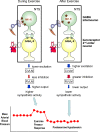Postexercise hypotension: central mechanisms
- PMID: 20577060
- PMCID: PMC2936915
- DOI: 10.1097/JES.0b013e3181e372b5
Postexercise hypotension: central mechanisms
Abstract
A single bout of exercise can lead to a postexercise decrease in blood pressure in hypertensive individuals, called postexercise hypotension. Compelling evidence suggests that the central baroreflex pathway plays a crucial role in the development of postexercise hypotension. This review focuses on the exercise-induced changes in brainstem nuclei involved in blood pressure regulation.
Figures





Comment in
-
Concerning postexercise hypotension.Exerc Sport Sci Rev. 2011 Apr;39(2):109. doi: 10.1097/JES.0b013e3182164376. Exerc Sport Sci Rev. 2011. PMID: 21430451 No abstract available.
References
-
- Ally A, Maher TJ. Endothelial NOS expression within the ventrolateral medulla can affect cardiovascular function during static exercise in stroked rats. Brain Res. 2008;1196:33–40. - PubMed
-
- Baude A, Strube C, Tell F, Kessler JP. Glutamatergic neurotransmission in the nucleus tractus solitarii: structural and functional characteristics. J Chem Neuroanat. 2009;38:145–153. - PubMed
-
- Boone JB, Jr., Corry JM. Proenkephalin gene expression in the brainstem regulates post-exercise hypotension. Brain Res Mol Brain Res. 1996;42:31–38. - PubMed
-
- Chandler MP, DiCarlo SE. Sinoaortic denervation prevents postexercise reductions in arterial pressure and cardiac sympathetic tonus. Am J Physiol. 1997;273:H2738–2745. - PubMed

